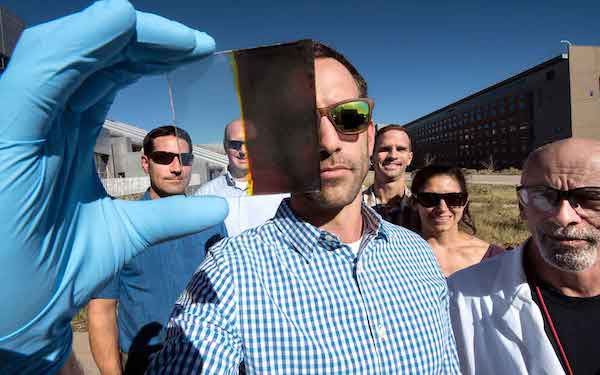
[Image above] Lance Wheeler (front) developed a switchable photovoltaic window along with (from left) Nathan Neale, Robert Tenent, Jeffrey Blackburn, Elisa Miller, and David Moore. Credit: Dennis Schroeder; NREL
Last year the United States generated 65% of electricity via fossil fuels, according to the U.S. Energy Information Administration. Only 15% came from renewable energy sources. Researchers all over the world continue to explore scalable options for harnessing the sun, wind, and water, among other renewable energy sources.
Some researchers are exploring ways to harness the sun’s energy and capture the heat that is already being lost through windows.
We’ve reported on a variety of research into window technologies this past year. Researchers have explored how nanometer-sized cones can eliminate glare. We’ve learned how window films that incorporate thermochromic technology use nanoparticles to reflect heat and infrared radiation.
We’ve also seen how user-controlled electrochromic windows reduce heat and light while still providing outside views. Other researchers have even developed electrochromic glass that changes color. And then there’s the self-tinting windows that change from clear to dark in less than 30 seconds by way of electrodeposition.
Window researchers have been busy this year!
Now, researchers at the U.S. Department of Energy’s National Renewable Energy Laboratory (NREL) have successfully demonstrated that thermochromic windows can convert sunlight into electricity at a high efficiency. The team, led by research scientist Lance Wheeler, developed a photovoltaic device that responds to sunlight through a switchable absorber layer, according to the team’s paper.
The absorber layer is made of a metal halide perovskite-methylamine complex. Energy from the sun causes the window device to heat up, driving out methylamine molecules and darkening the device to less than 3% visibility. When it’s cloudy out, the device is cool and the molecules are absorbed back into the device, which generates electricity. The window device switches back to a transparent state at 68% visibility.
Wheeler says there is a tradeoff between solar efficiency and visible light transmittance, a weakness that limits photovoltaic window designs currently on the market. “There is a fundamental tradeoff between a good window and a good solar cell,” he explains in an NREL news release. “This technology bypasses that. We have a good solar cell when there’s lots of sunshine and we have a good window when there’s not.
“There are thermochromic technologies out there but nothing that actually converts that energy into electricity,” he adds.
The researchers cycled the device through several repeated tint-transparent cycles. According to the release, the performance of the window device declined after 20 cycles, “due to restructuring of the switchable layer.” They plan to continue their research to improve cycling stability.

Composition and performance of switchable photovoltaic window devices. a) Schematic of PV window device architecture and switching process. b) Transmittance of PV devices in the bleached (red) and colored (blue) states as a function of wavelength. c) Current density as a function of voltage of the champion switchable PV device in the dark (dashed) and under illumination (solid). The inset table shows PV performance metrics of the device before being bleached. d) Short-circuit current as a function of time for 20 cycles of 3 min of illumination followed by 5 min of cooling in the dark. e) Short-circuit current as a function of time for the first illumination cycle. The optical images were extracted from Supplementary Movie 1 to show the transition from bleached to colored and back to bleached at the indicated times during the cycling process. Credit: Wheeler et al., NREL
Wheeler and his team have already sought out industry advisers to determine if the device would be marketable through Energy I-Corps—a program that pairs researchers with mentors to explore the feasibility of a product. He and Robert Tenent, another researcher at NREL and program lead for window technology, have created a marketing strategy and have named their photovoltaic glass SwitchGlaze.
The product could be used in buildings and even vehicles. Wheeler says the electricity SwitchGlaze generates could power smartphone batteries or even window motors and rain sensors in vehicles, for example.
Perhaps in due time the U.S. can eventually move beyond that 15%.
The paper, published in Nature Communications, is “Switchable photovoltaic windows enabled by reversible photothermal complex dissociation from methylammonium lead iodide” (DOI: 10.1038/s41467-017-01842-4).
Did you find this article interesting? Subscribe to the Ceramic Tech Today newsletter to continue to read more articles about the latest news in the ceramic and glass industry! Visit this link to get started.
Author
Faye Oney
CTT Categories
- Basic Science
- Electronics
- Energy
- Environment
- Glass
- Market Insights
- Material Innovations


